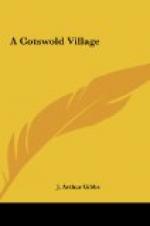The lover of horses and riding finds here a paradise of grassy glades, where he can gallop for miles on end, and tire the most obstinate of “pullers.”
Picnic parties, horse shows, cricket matches, and the chase of the fox all find a place in this romantic demesne in their proper seasons. The enthusiast for woodland hunting, or the man who hates the sight of a fence of any description, may hunt the fox here day after day and never leave the recesses of the park.
The antiquary will find much to delight him. Here is the ancient high cross, erected in the fourteenth century, which once stood in front of the old Ram Inn. The pedestal is hewn from a single block of stone, and beautifully wrought with Gothic arcades and panelled quatrefoils; this and the shaft are the sole relics of the old cross. We may go into raptures over the ivy-covered ruin known as Alfred’s Hall, fitted up as it is with black oak and rusty armour and all the pompous simplicity of the old baronial halls of England. Antiquaries of a certain order are easily deceived; and this delightful old ruin, though but two hundred years old, has been so skilfully put together as to represent an ancient British castle. That celebrated, though indelicate divine, Dean Swift, was, like Alexander Pope, deeply interested in the designing of this park.
As long ago as 1733 Alfred’s Hall was a snare and delusion to antiquaries. In that year Swift received a letter stating that “My Lord Bathurst has greatly improved the Wood-House, which you may remember was a cottage, not a bit better than an Irish cabin. It is now a venerable castle, and has been taken by an antiquary for one of King Arthur’s.”
The kennels of the V.W.H. hounds are in the park. Here the lover of hounds can spend hours discussing the merits of “Songster” and “Rosebud,” or the latest and most promising additions to the families of “Brocklesby Acrobat” or “Cotteswold Flier.”
In this house are some very interesting portraits. Full-length pictures of the members of the Cabal Ministry adorn the dining-room—all fine examples of Lely’s brush; then there is a very large representation of the Duke of Wellington at Waterloo mounted on his favourite charger “Copenhagen” by Lawrence; two “Romneys,” one “Sir Joshua,” and several “Knellers.”
Turning to the Abbey, the seat for the last three hundred and thirty years of the Master family, we find another instance of a large country house standing practically in a town. The house is situated immediately behind the church and within a stone’s throw of the market-place. But on the side away from the town the view from this house extends over a large extent of rural scenery. The site of the mitred Abbey of Saint Mary is somewhere hereabouts, but in the time of the suppression of the monasteries every stone of the old abbey was pulled down and carried away; so that the twelfth-century gateway and some remnants of pillars are the sole traces that remain.




